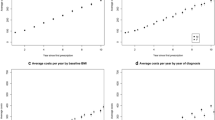Abstract
Medical treatments change over time for multiple reasons, including introduction of new treatments, availability of new scientific evidence, change in institutional guidelines, and market efforts by pharmaceutical and medical device companies. Monitoring and analyzing these secular trends will also inform the evaluation of evidence based practice as well as outcome research. Using a large national clinical dataset from the United States Veterans Health Administration (VHA), we measured the change in prevalence of all diseases, medications, and procedures by year from 2001 to 2014. To assess statistical significance, we used a generalized linear model. Among the large number of changes that were observed, multiple significant changes were related to diabetes mellitus type II (DM2). Prevalence of DM2 in the VHA increased after 2001 but plateaued by 2008; blood sugar testing by glycosylated hemoglobin increased consistently while glucose testing decreased; and the trend of insulin and metformin use was consistent with the trend in DM2 prevalence, while glyburide and rosiglitazone use dropped sharply.



Similar content being viewed by others
References
Pepin, J., Valiquette, L., Alary, M. E., Villemure, P., Pelletier, A., Forget, K., Pepin, K., and Chouinard, D., Clostridium difficile-associated diarrhea in a region of Quebec from 1991 to 2003: a changing pattern of disease severity. CMAJ: Canadian Medical Association Journal = Journal de l'Association Medicale Canadienne. 171(5):466–472, 2004. https://doi.org/10.1503/cmaj.1041104.
Etzioni, D. A., Mack, T. M., Beart, Jr., R. W., and Kaiser, A. M., Diverticulitis in the United States: 1998-2005: changing patterns of disease and treatment. Ann. Surg. 249(2):210–217, 2009. https://doi.org/10.1097/SLA.0b013e3181952888.
Campbell, J. A., Soliman, A. S., Kahesa, C., Harlow, S. D., and Msemo, D., Changing Patterns of lung, liver, and head and neck non-AIDS-defining cancers relative to HIV status in Tanzania between 2002-2014. Infect Agent Cancer. 11:58, 2016. https://doi.org/10.1186/s13027-016-0106-5.
Hasan, Y., Waller, J., Yao, K., Chmura, S. J., and Huo, D., Utilization trend and regimens of hypofractionated whole breast radiation therapy in the United States. Breast Cancer Res. Treat. 162(2):317–328, 2017. https://doi.org/10.1007/s10549-017-4120-0.
Mease, P. J., Lesperance, T., Liu, M., Collier, D. H., Mason, M., Deveikis, S., and Accortt, N. A., Changes in Treatment Patterns in Patients with Psoriatic Arthritis Initiating Biologic and Nonbiologic Therapy in a Clinical Registry. J. Rheumatol. 44(2):184–192, 2017. https://doi.org/10.3899/jrheum.160343.
Topaz, M., Shafran-Topaz, L., and Bowles, K. H., ICD-9 to ICD-10: evolution, revolution, and current debates in the United States. Perspect Health Inf Manag. 1d:10, 2013.
Yang, X., Soohoo, M., Streja, E., Rivara, M. B., Obi, Y., Adams, S. V., Kalantar-Zadeh, K., and Mehrotra, R., Serum Magnesium Levels and Hospitalization and Mortality in Incident Peritoneal Dialysis Patients: A Cohort Study. Am. J. Kidney Dis. 68(4):619–627, 2016. https://doi.org/10.1053/j.ajkd.2016.03.428.
Bonferroni, CE. Teoria statistica delle classi e calcolo delle probabilità. Pubblicazioni del R Istituto Superiore di Scienze Economiche e Commerciali di Firenze, 1936.
Chiniwala, N., and Jabbour, S., Management of diabetes mellitus in the elderly. Curr Opin Endocrinol Diabetes Obes. 18(2):148–152, 2011. https://doi.org/10.1097/MED.0b013e3283444ba0.
Loke, Y. K., Kwok, C. S., and Singh, S., Comparative cardiovascular effects of thiazolidinediones: systematic review and meta-analysis of observational studies. BMJ 342:d1309, 2011. https://doi.org/10.1136/bmj.d1309.
Olokoba, A. B., Obateru, O. A., and Olokoba, L. B., Type 2 diabetes mellitus: a review of current trends. Oman Med J. 27(4):269–273, 2012. https://doi.org/10.5001/omj.2012.68.
Lee, S. J., Boscardin, W. J., Stijacic Cenzer, I., Huang, E. S., Rice-Trumble, K., and Eng, C., The risks and benefits of implementing glycemic control guidelines in frail older adults with diabetes mellitus. J. Am. Geriatr. Soc. 59(4):666–672, 2011. https://doi.org/10.1111/j.1532-5415.2011.03362.x.
Miedema, K., Standardization of HbA1c and Optimal Range of Monitoring. Scand. J. Clin. Lab. Investig. Suppl. 240:61–72, 2005. https://doi.org/10.1080/00365510500236143.
Doing-Harris, K., Patterson, O., Igo, S., and Hurdle, J., Document sublanguage clustering to detect medical specialty in cross-institutional clinical texts. San Francisco. 2512101: ACM: Proceedings of the 7th international workshop on Data and text mining in biomedical informatics, 2013, 9–12.
Friedman, C., Kra, P., and Rzhetsky, A., Two biomedical sublanguages: a description based on the theories of Zellig Harris. J. Biomed. Inform. 35:222–235, 2002. https://doi.org/10.1016/S1532-0464(03)00012-1.
Patterson, O., and Hurdle, J. F., Document clustering of clinical narratives: a systematic study of clinical sublanguages. AMIA Annual Symposium proceedings / AMIA Symposium AMIA Symposium. 2011:1099–1107, 2011.
Zeng, Q. T., Redd, D., Divita, G., Jarad, S., Brandt, C., and Nebeker, J. R., Characterizing Clinical Text and Sublanguage: A Case Study of the VA Clinical Notes. J Health Med Informat. 4(2), 2011. https://doi.org/10.4172/2157-7420.S3-001.
Funding
This study was funded by
• HIR 08–374 VA Health Services Research and Development Consortium for Healthcare Informatics Research (CHIR)
• HIR 08–204 Veterans Affairs Health Services Research & Development, VA Informatics and Computing Infrastructure (VINCI) aka Center for Scientific Computing
• CRE 12–315 Veterans Affairs Health Services Research & Development, CREATE: A VHA NLP Software Ecosystem for Collaborative Development and Integration
• UL1TR001876 and KL2TR001877 NIH National Center for Advancing Translational Sciences, Clinical and Translational Science Institute at Children's National (CTSI-CN), National Institutes of Health (NIH) Clinical and Translational Science Award (CTSA)
Author information
Authors and Affiliations
Corresponding author
Ethics declarations
Conflict of interest
The authors declare no conflict of interests.
Ethical approval
All procedures performed in studies involving human participants were in accordance with the ethical standards of the institutional and/or national research committee and with the 1964 Helsinki declaration and its later amendments or comparable ethical standards.
Additional information
Publisher’s Note
Springer Nature remains neutral with regard to jurisdictional claims in published maps and institutional affiliations.
This article is part of the Topical Collection on Systems-Level Quality Improvement
Rights and permissions
About this article
Cite this article
Redd, D., Shao, Y., Cheng, Y. et al. Detecting Secular Trends in Clinical Treatment through Temporal Analysis. J Med Syst 43, 74 (2019). https://doi.org/10.1007/s10916-019-1173-0
Received:
Accepted:
Published:
DOI: https://doi.org/10.1007/s10916-019-1173-0




